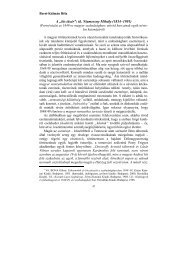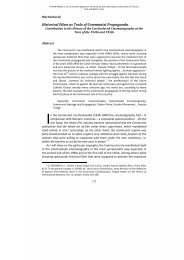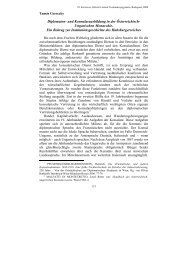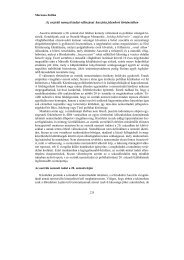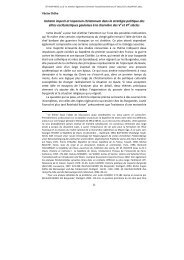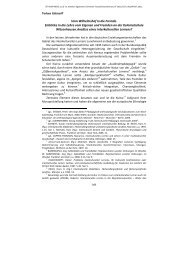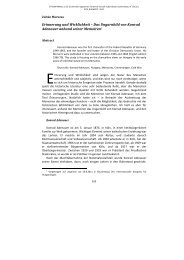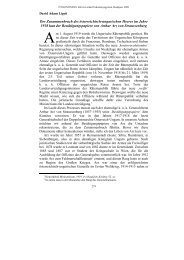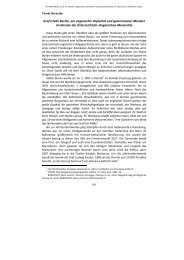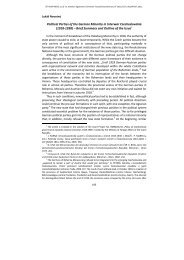You also want an ePaper? Increase the reach of your titles
YUMPU automatically turns print PDFs into web optimized ePapers that Google loves.
László Gulyás - Loránt Bali: <strong>The</strong> <strong>Fiume</strong> <strong>Question</strong> <strong>1918</strong>-<strong>1920</strong><br />
parliament, Andrea Ossoinack, held a parliamentary speech, in which he<br />
emphasized that <strong>Fiume</strong> had never been part of Croatia; it was Italian and it should<br />
remain a part of Italy. 4<br />
In October <strong>1918</strong> parallelly two national councils came into being in the city. On<br />
the one hand it was the Italians who set up the Italian National Council of <strong>Fiume</strong>,<br />
and, on the other, the Croatians brought about the <strong>Fiume</strong> Committee of the<br />
Zagreb National Council. <strong>The</strong> birth of these two parallel bodies is indicative of the<br />
fact that the Italian-Croatian struggle for <strong>Fiume</strong> started. <strong>The</strong> Croatian army<br />
entered <strong>Fiume</strong> on October 23. <strong>The</strong> last week of October in <strong>Fiume</strong> can best be<br />
described by marching soldiers. In several of the city’s streets Croatian soldiers<br />
marched under their Croatian flag, while in other streets it was the Italians who<br />
marched under their Italian flags. 5<br />
This situation rightfully raises another question. Where were <strong>Fiume</strong>’s<br />
Hungarian leaders and inhabitants during these events? <strong>The</strong> answer to this<br />
question is simple. Zoltán Jékelfalussy, <strong>Fiume</strong>’s last Hungarian governor, having<br />
realised that the Hungarians did not stand a chance to fight back the Italian or the<br />
Croatian crowds of demonstrators, left for Budapest on October 28th. After the<br />
governor left, the office holders of the Hungarian state, including public servants,<br />
employees, soldiers, policemen, office workers, railwaymen, also fled. In the city of<br />
<strong>Fiume</strong> these groups of Hungarian people did not see their lives and their future<br />
secure. 6<br />
<strong>Fiume</strong>’s Italian population, as well as the Croatians aimed at solving the<br />
situation for their own good. In order to come to a decision, the Italian National<br />
Council of <strong>Fiume</strong>, presided by Grossich Antonio, in the city’s main square on<br />
October 30, <strong>1918</strong> proclaimed the city’s annexation to Italy. 7 <strong>The</strong> Italian-Croatian<br />
rivalry is illustrated well by the fact, that the official Croatian delegation arrived<br />
from Zagreb on the very same day to take charge of the city. Comissar Rajčevič,<br />
head of the delegation, moved into the governor’s mansion. Antonio Grossich<br />
immediately protested in the name of the Italian National Council and declared<br />
that they would support the union with their mother country, i.e. Italy, and look<br />
upon the Southern Slav occupation as a temporary situation. During the following<br />
days the Croatian-Italian conflicts were becoming strained in <strong>Fiume</strong>. One of the<br />
special features of this relationship was the changing of the flags. <strong>The</strong> Croatians<br />
removed the Italian flags from the buildings, while the Italians did the same with<br />
the Croatian flags. On public buildings this changing of the flag took place on<br />
several occasions. In addition, there were a lot of violent crimes, looting, burglary<br />
and theft.<br />
4<br />
FRIED Ilona, <strong>Fiume</strong>, Enciklopédia Kiadó, Budapest 2004, 22.<br />
5<br />
HORVÁTH József, A magyar <strong>Fiume</strong> végnapjai 1914-1924, Hadtörténelmi Közlemények, 2003/1.<br />
szám 172-175.<br />
6<br />
HAJDÚ Zoltán, <strong>Fiume</strong> (Rijeka) kérdéséről. IN: PAP Norbert (szerk.), A Balatontól az Adriáig, Lomart<br />
Kiadó, Pécs 2006, 104-109.<br />
7<br />
FRIED 2004, 22.<br />
144



